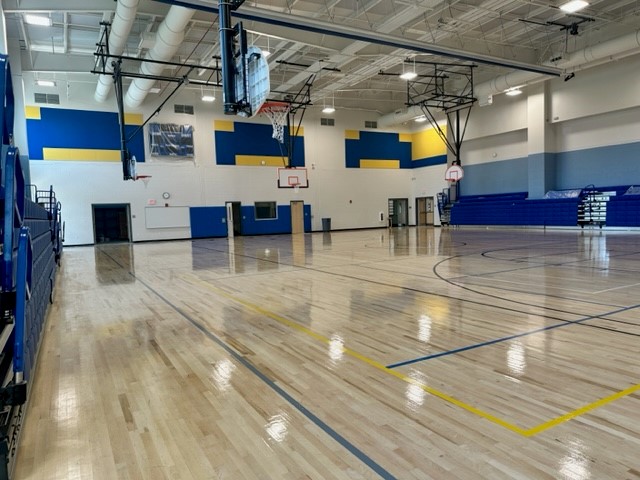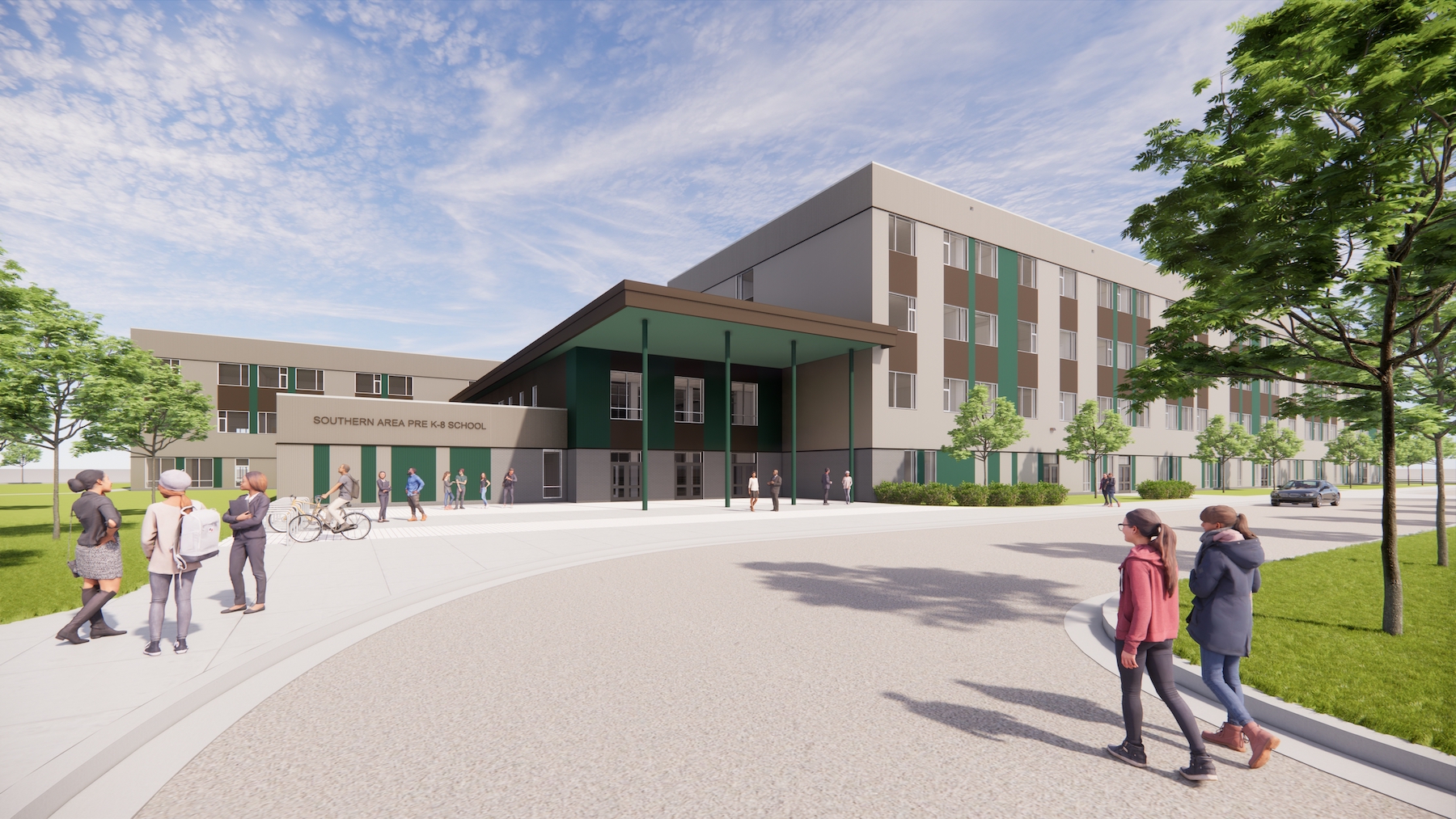Next month, Prince George’s County Public Schools (PGCPS) is scheduled to open the Colin L. Powell K-8 Academy in Fort Washington, Md., a 233,865-ft school with an occupancy of 2,000, whose construction budget is $106.2 million, according to the school district.
This is one of six schools that were built under PGCPS’s Blueprint Schools Program, a collaborative public-private partnership that has significantly reduced the schools’ construction time and cost.
The five other schools, which opened last August, are the 144,800-sf Drew-Freeman Middle School for classes 6-8 in Hillcrest Heights, Md.; the 162,610-sf Hyatt Middle School in Hyattsville, Md.; the 144,800-sf Kenmore School in Landover, Md., for 1,200 6th through 8th graders; the 144,800-sf Sonia Sotomayor Middle School in Adelphi, Md.; and the 144,800-sf Walker Mill Middle School in Capital Heights, Md., with a 1,200-person capacity.
In addition to STEAM labs with 3D printers and robotics, each Blueprint school will feature a video production studio, community clinics, and media center. The schools are solar- and electric vehicle charging-ready, with solar installation slated for completion in the fall of 2024. Hyattsville includes a black-box theater. And Colin Powell will have an elementary library, four Pre-K classrooms, and auxiliary gym, and innovation lab.
Commitment to diversity
The P3, known as Prince George’s County Education and Community Partners (PGCECP), delivered these schools in just 2½ years. Without this P3 agreement, it would have taken 16 years to fund and build them, according to Bob Hunt, Group Managing Director-Government, Education, and Non Profit Advisory for JLL, which served as the technical and financial advisor to PGCPS.
The P3 team includes development and financing members Fengate Asset Management and Gilbane Development Company, Gilbane Building Company (lead design-builder), Stantec (architect and design lead), and Honeywell (lead services provider).

The Blueprint program’s planning, outreach, and support are geared toward increasing opportunities for small businesses, county-based businesses, and minority business enterprises. Scopes of work are created, and larger contracts are unbundled, to expand these businesses’ participation. This includes ongoing prequalification for all anticipated contracts for each key team member.
As of August 2023, PGCECP had exceeded its goal by awarding $134 million, or one-third, of its contracts for the schools built under Blueprint to Minority-owned businesses such as Arel Architects, which is part of the P3’s design team and has a mentor-protégé relationship with Stantec. Warren Builds Construction and Corenic Construction Group have similar arrangements with Gilbane. Three|E Consulting Group, a county-based business, serves as the economic inclusion and compliance team.
The next phase with more partners
Under a traditional design-bid-build contract, PGCPS estimates that the six schools would have cost an aggregate $868.8 million to design and construct. The schools in the Blueprint program were completed for a total of $485.8 million and include 30 years of facilities maintenance from Honeywell, which must adhere to MBE/CBB procurement requirements. PGCPS projects a savings of $170 million over three decades, compared to the traditional model.
Phase II of the Blueprint program will deliver eight more schools that further meet the needs of the district's 133,000 students and nearly 20,000 employees. Prince George’s County Education Collective was recently selected as Phase II’s final bidder. The Collective consists of equity members Plenary Americas US Holdings and Ellis Don Capital; MBE equity member Phoenix Infrastructure Group Investments, lead contractor MCN Build, and lead service providers US Facilities, Ellis Don Facilities Services, and RSC Electrical and Mechanical.
Related Stories
K-12 Schools | Apr 10, 2024
Surprise, surprise: Students excel in modernized K-12 school buildings
Too many of the nation’s school districts are having to make it work with less-than-ideal educational facilities. But at what cost to student performance and staff satisfaction?
K-12 Schools | Apr 1, 2024
High school includes YMCA to share facilities and connect with the broader community
In Omaha, Neb., a public high school and a YMCA come together in one facility, connecting the school with the broader community. The 285,000-sf Westview High School, programmed and designed by the team of Perkins&Will and architect of record BCDM Architects, has its own athletic facilities but shares a pool, weight room, and more with the 30,000-sf YMCA.
Security and Life Safety | Mar 26, 2024
Safeguarding our schools: Strategies to protect students and keep campuses safe
HMC Architects' PreK-12 Principal in Charge, Sherry Sajadpour, shares insights from school security experts and advisors on PreK-12 design strategies.
K-12 Schools | Mar 18, 2024
New study shows connections between K-12 school modernizations, improved test scores, graduation rates
Conducted by Drexel University in conjunction with Perkins Eastman, the research study reveals K-12 school modernizations significantly impact key educational indicators, including test scores, graduation rates, and enrollment over time.
K-12 Schools | Feb 29, 2024
Average age of U.S. school buildings is just under 50 years
The average age of a main instructional school building in the United States is 49 years, according to a survey by the National Center for Education Statistics (NCES). About 38% of schools were built before 1970. Roughly half of the schools surveyed have undergone a major building renovation or addition.
Construction Costs | Feb 22, 2024
K-12 school construction costs for 2024
Data from Gordian breaks down the average cost per square foot for four different types of K-12 school buildings (elementary schools, junior high schools, high schools, and vocational schools) across 10 U.S. cities.
K-12 Schools | Feb 13, 2024
K-12 school design trends for 2024: health, wellness, net zero energy
K-12 school sector experts are seeing “healthiness” for schools expand beyond air quality or the ease of cleaning interior surfaces. In this post-Covid era, “healthy” and “wellness” are intersecting expectations that, for many school districts, encompass the physical and mental wellbeing of students and teachers, greater access to outdoor spaces for play and learning, and the school’s connection to its community as a hub and resource.
K-12 Schools | Jan 25, 2024
Video: Research-based design for K-12 schools
Two experts from national architecture firm PBK discuss how behavioral research is benefiting the design of K-12 schools in Texas, Florida, and other states. Dan Boggio, AIA, LEED AP, NCARB, Founder & Executive Chair, PBK, and Melissa Turnbaugh, AIA, NCARB, Partner & National Education & Innovation Leader, PBK, speak with Robert Cassidy, Executive Editor, Building Design+Construction.
K-12 Schools | Jan 8, 2024
Video: Learn how DLR Group converted two big-box stores into an early education center
Learn how the North Kansas City (Mo.) School District and DLR Group adapted two big-box stores into a 115,000-sf early education center offering services for children with special needs.
Designers | Jan 3, 2024
Designing better built environments for a neurodiverse world
For most of human history, design has mostly considered “typical users” who are fully able-bodied without clinical or emotional disabilities. The problem with this approach is that it offers a limited perspective on how space can positively or negatively influence someone based on their physical, mental, and sensory abilities.

















